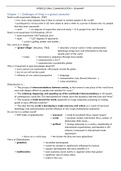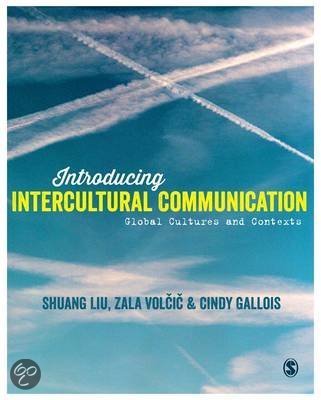INTERCULTURAL CUMMUNICATION – SUMMARY
Chapter 1 – Challenges of living in a global community
Small world experiment (Milgram, 1967)
> how many steps/people does it take to connect to random people in the world?
> participants in various cities in US were asked to send a letter to a person in Boston only via people
that they knew personally
> result > six degrees of separation (network study) > 5/6 people from start till end
Small word experiment 2.0 (Facebook, 2012)
> same experiment with Facebook users
> result > 3,57 degrees of separation
> world is getting smaller and smaller…
The world as a village
> “global village” (McLuhan, 1962) > describes a future world in which communication
technology brings news and information to the most
remote parts of the world
> today > information is ubiquitous (through mass media)
> communication is 24/7
> communication is potentially global
Why is it important to gain knowledge about IC?
> every person can communicate with people around the globe
> but we are still not the same!
> influence of own cultural perspective > language
> communication style (formal/informal…)
> value orientations
Globalization is…
> “The process of interconnectedness between society, so that events in one place of the world have
more and deeper effects on people and societies far away.”
> “The widening, deepening, and speeding up of the worldwide interconnectedness in all aspects
of contemporary social life. This interconnectivity breaks down the boundary between East and West.”
> “The increase of trade around the world, especially by large companies producing or trading
goods in many different countries.”
> “The idea that the world is developing a single economy and culture as a result of improved
technology and communications and the influence of very large multinational companies.”
Do we live in a unified world?
> KOF Index of globalization > economic > trade & investment flows, import/export
> social > personal contact, information flows, number of
McDonalds, IKEA stores…
> political > foreign embassies in a country, membership of
international organizations, participation in UN
missions, involvement in international trade
agreements
> shown on a world map > the darker the blue, the more globalized
Views of Globalization
> globalists > inevitable development
> cannot be resisted or significantly influenced by humans
> support development/see many benefits in it
> traditionalists > most economic/social activity is regional rather than global
> significant role of nation-states
> prefer it this way
, INTERCULTURAL CUMMUNICATION – SUMMARY
> transformationalists > significant shift but still significant scope for national, local and other
agencies
Globalization = diversity?
> globalization leading to a more diversified or to a more uniform world?
Global cultural diversity
> today about 5000 distinct cultures with their languages
> representing at least 300 distinct phyla (linguistic families)
> biological and cultural diversity together
> environmental factors > geographical
barriers breed
divergence
> tropical climates
support more life
> sociocultural factors > smaller groups
highly adaptable
> multilingualism is the global norm
Contributors to cultural contact
> advanced technology and transportation & increased mobility
> easier to travel & move for economic or lifestyle opportunities
> easier to interact online via ever-changing apps & modalities
> smaller, yet more diverse world
> understanding other cultures is a challenge we face on an everyday basis
> globalized economy and business
> global transformation: local market as diverse as global market
> international expansion: MNCs operating globally, outsourcing to low-wage
countries > economy no longer national but global
> diverse workforce: migrant workers, expats
> understanding cultural tensions creating by economic transformations is a challenge we face
in intercultural communication in business contexts (BREXIT, TTIP, EU, NATO)
> mass migration and international exchange
> 5% of global population is mobile
> immigration flows (from developing to developed countries)
> refugees from war-torn countries
> migrant workers who move to a host country temporarily
> student exchanges
> expats who temporarily relocate to work in another country
> facilitating intercultural co-existence is a challenge we face in our societies
Necessity and benefits of IC
> societies are increasingly multicultural, made up of diverse cultures
= multiculturalism at descriptive level
> living and working together requires mutual understanding and tolerance
> ‘melting pot’ societies flourish when there is acceptance of equal societal participation of
diverse groups = multiculturalism at attitudinal level
> therefore: necessary to study intercultural communication and gain intercultural
communicative competence, to build intercultural understanding
> building intercultural understanding
> become aware of cultural rules by being confronted with cultural rules of others
> promoting international business exchange
> communicating with unfamiliar cultures does not simple mean finding a translator
, INTERCULTURAL CUMMUNICATION – SUMMARY
> business is building relationships (e.g. Chinese guanxi: trust, favour, dependence,
adaptation)
> so: understanding cultures and cultural differences is the key to successful business exchange
> facilitating cross-cultural adaptation
> tension between immigrants and host nationals often centers on the issue of cultural
maintenance
> melting pot or salad bowl?
> in today’s world, all countries are interdependent and share a common future
> intercultural communication can play an irreplaceable in this historical undertaking
Chapter 2 – Culture and people
Defining culture
> many different definitions in scientific literature
> in common > culture is pervasive in human life
> culture governs people’s behaviors
> metaphors > People see the world through cultural glasses
> People see the world through a window
> Culture is the luggage we carry
> Culture is like the water fish swim in
> Culture is like the air we breathe
> Web that people have spun
> culture confines members to their social reality and facilitates their
functioning in it
> culture is product and process
> culture provides context for behavior
> Iceberg > visible > symbols, rituals…
> invisible > values, norms…
> Onion > symbols – heroes – rituals – values (superficial to deep)
> Software > culture as hardwired program in our mind
> needs to be installed
> Tree > bottom to top
> fundamental concerns – values – outward expressions
> dynamic
> may be defined as
> “the particular way of life of a group of people and the meaning-making process
by which people make sense of their social world”
> “culture compromises the deposit of knowledge, experience, beliefs, values, traditions,
religion, notions of time, roles, spatial relations, worldviews, material objects, and geographic
territory”
Culture as “layered” (Dodd’s (1998) model)
> inner core > aspects underlie and shape
culture and the behavior
> history: carrier of cultural heritage,
provides continuity
> identity: sense of ‘who we are’ or ‘who I
am’
> beliefs: what a culture believes as true
or false
> values: what a culture regards as good
or bad






